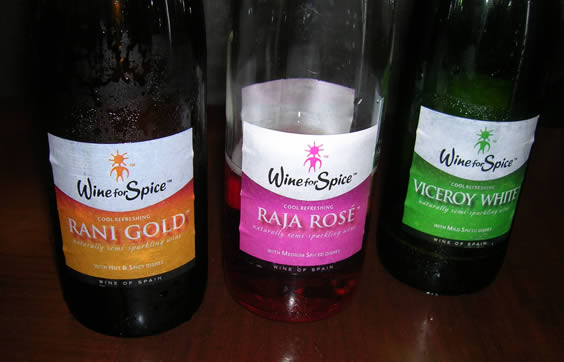
|
Wine
for spice
Warren Edwardes (pictured
below) is the man behind a rather unusual set of wines. Titled ‘Wine
for Spice’, his range of two whites and a rosé is designed with
spicy Asian food in mind. I caught up with him for a meal at upmarket
curry house Masala Zone (www.masalazone.com).
Warren has an interesting background. He’s from Dehli, but has Goan
roots. He went to a Jesuit boarding school in Rajistan, where he had
his first experience of wine at the 5.30 am mass that started each
day. And his current venture follows a career in investment banking. Since I last saw his wines,
they’ve changed their look a bit. The new labels are ‘a lot more
feminine’, Warren claims. ‘We’re also aiming at the summer
market: the key word is “refreshing”; anything that works in
summer should also work with curry’. That means acidity, no oak and
not tannin. Low temperature, sparkling, and not too high alcohol. This
is Warren’s equation for a successful match with spice.
Warren used to drink
Torres’ Vina Esmerelda at home, a blend of Muscat and Gewürztraminer
with 11 g/l residual sugar. (Viceroy Gold is 19 g/l residual sugar.)
‘I find Gewürztraminer/Muscat a bit cloying after the first glass:
it’s a bit too much’, says Warren. He experimented and mixed the
Esmerelda half and half with Muscadet, which was much more refreshing,
and then mixed it with Cava, which led to the semi-sparkling idea.
‘You lose a lot of the nuances with spice’, says Warren, ‘and
you’re left with the textural and acid characteristics.’ Clearly, these are wines
with a function in mind. ‘They are not terroir wines’, admits
Warren. ‘They are good gluggers: these wines can be produced
anywhere because the key is vinification, not viticulture’. In fact,
the wines all come from northeast Spain. Wines for Spice Viceroy
White NV Wines for Spice Raja Rosé
NV Wines for Spice Rani Gold
NV These wines are available
from some branches of Waitrose, as well as directly from the Wine for
Spice company. Website: http://wineforspice.com/ wines tasted: August 2007 [Earlier report from a few years back] The wines themselves are sourced from Cavas del Ampurdas,
Perelada, in Spain’s Costa Brava. They are all made in a rarely seen
semi-sparkling style, and there’s a dry white, a semi-sweet white
and a semi-sweet rosé. Below are my notes on the wines and how they
faired with the curries. Surprisingly, the fizziness and sweetness in
tandem work very well in the two sweeter wines. Viceroy White Dry NV Raja Rosé Medium Dry NV Rani Gold Medium Dry NV So, the crunch question: if I was dining in a curry house and saw Warren’s wines on the list, would I opt for them or stick with my beer? In all honesty, I’d go for the beer. Habits are hard to break. But if I was with someone who wanted wine, I’d probably give the Rani Gold a go in preference to a more conventional selection. Contact details:
wine for spice ltd
3 hyde park steps
st. george's fields
london W2 2YQ, UK
t: +44 (0) 20 7724 4606
m: +44 (0) 794 191 6328
f: +44 (0) 870 132 0055
|

 The
most distinctive feature of the Wine for Spice range is that these
wines are fizzy, but not as fizzy as Champagne. Champagne typically
has a pressure of 6 bars, whereas these wines come in at 2.4 bars.
This semi-sparlking style is produced by the charmant method. His
wines all have some residual sugar, too, rising with the spiciness of
the dish. Thermometer images are used on the label to indicate this.
The
most distinctive feature of the Wine for Spice range is that these
wines are fizzy, but not as fizzy as Champagne. Champagne typically
has a pressure of 6 bars, whereas these wines come in at 2.4 bars.
This semi-sparlking style is produced by the charmant method. His
wines all have some residual sugar, too, rising with the spiciness of
the dish. Thermometer images are used on the label to indicate this.